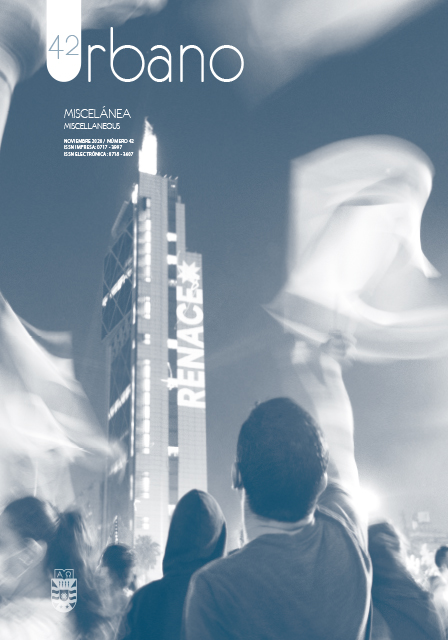Socio-spacial habitus in coastal communities under the neoliberal context. The case of El Morro Cove, Talcahuano
DOI:
https://doi.org/10.22320/07183607.2020.23.42.05Keywords:
differential space, to inhabit, socio-spatial habitus, neoliberalism, urban coveAbstract
Coves are coastal settlements, marked by their productive vocation, linked to artisanal fishing. In them, specific forms of inhabiting appear that give rise to socio-spatial practices that produce and reproduce space and that in this document, we will call socio-spatial habitus (Giglia, 2012). Currently, these settlements and communities have been threatened by the homogenizing advance of neoliberal urban expansion. This article describes the characteristics of the socio-spatial habitus of El Morro Cove in Talcahuano and its expressions during and after the 2010 tsunami. The methodology incorporates qualitative techniques such as interviews and the revision of photographic archive material; and quantitative, such as a review of statistics and territorial planning instruments. The analysis is a cartographic and historical synthesis of the socio-spatial practices of the cove, its nodes and potentialities for the preservation of the settlement and its culture. The results show that the cove is positioned as a frontier within the urban space, a heterotopia (Lefebvre, 2013), which resists natural threats and abstract space, characterized by global urbanization that threatens the regional and national coastline.
Downloads
References
Alarcón, M. y Sandoval, P. (2016). Transformación del frente portuario de Talcahuano: Oportunidades para la integración urbana. En Hidalgo, R., Santana, D., Alvarado, V., Arenas, F., Salazar, A., Valdebenito, C. y Álvarez, L. (Eds.), En las
Costas del Neoliberalismo (pp. 144- 165). Santiago de Chile: Instituto de Geografía, Pontificia Universidad Católica de Chile.
Baringo, D. (2013). La tesis de la producción del espacio en Henri Lefebvre y sus críticos: un enfoque a tomar en consideración. Revista Quid, 16(3), 119-135. Recuperado de https://publicaciones.sociales.uba.ar/index.php/quid16/article/view/1133
Bourdieu, P. (1991). El sentido práctico. Madrid: Taurus.
Foucault, M. (1967). Des espaces autres. Conférence au cercle d’études architecturales. Architecture, Mouvement, Continuité, 5, 46-49.
Gajardo, C. y Ther, F. (2011). Saberes y prácticas pesquero-artesanales: cotidianeidades y desarrollo de las caletas de Guabún y Puñihuil, Isla de Chiloé. Revista Chungará, 43(1), 589-605. Recuperado de https://scielo.conicyt.cl/scielo.php?script=sci_arttext&pid=S0717-73562011000300014
Guerrero, R. y Alarcón, M. (2018). Neoliberalismo y transformaciones socioespaciales en caletas urbanas del Área Metropolitana de Concepción. Los casos de Caleta Los Bagres y Caleta Cocholgüe, Tomé. Revista de Urbanismo, 38, 1-17. DOI: http://dx.doi.org/10.5354/0717-5051.2018.48666
Giglia, Á. (2012). El habitar y la cultura. Madrid: Siglo XXI.
Harvey, D. (2012). Ciudades rebeldes: del derecho de la ciudad a la revolución urbana. Madrid: Ediciones Akal.
Hidalgo, R. Santana, D. Alvarado, V. Arenas, F. Salazar, A. Valdebenito, C. y Álvarez, L. (Eds.) (2016). En las costas del neoliberalismo. Naturaleza, urbanización y producción inmobiliaria: experiencias en Chile y Argentina. Santiago de Chile: Serie GEOlibros N° 23, Instituto de Geografía, Pontificia Universidad Católica de Chile - Instituto de Geografía, Pontificia Universidad Católica de Valparaíso.
Lefebvre, H. (2013). La producción del espacio. Madrid: Capitan Swing Libros.
Marcucci, D. (2014). Coastal resilience: new perspectives of Spatial and productive development for the Chilean caletas Exposed to Tsunami Risk. Procedia Economics and Finance, 14, 39-46. DOI: https://doi.org/10.1016/S2212-5671(14)00911-3
McGodwin, J. (2002). Comprender las culturas de las comunidades pesqueras. Clave para la ordenación pesquera y la seguridad alimentaria. Roma: FAO.
Moussard, M., Carrasco, N., Aliste, E., Ther, F. y Hidalgo, C. (2013). Caleta El Morro de Talcahuano: Sobrevivencia de una comunidad pesquera al tsunami de 2010 en Chile. Revista Márgenes, 10(13), 69-78. Recuperado de https://revistas.uv.cl/index.php/margenes/article/view/327
Orellana, A. y Díaz, M. (2016). Las Caletas de Chile: Integración urbana y prevalencia de sus valores patrimoniales. El caso de bahía de Coquimbo. Revista de Urbanismo, 34, 55-72. DOI: http://dx.doi.org/10.5354/0717-5051.2016.40078
Orellana, A. y Díaz, M. (2017). Caletas de la Provincia del Elqui. Patrimonio acumulativo en la ocupación del borde costero. Revista AUS, (23), 56-64. DOI: https://doi.org/10.4206/aus.2018.n23-09
Riffo, C., Pérez, L. (2016). Desplazamiento y regeneración: formas alternativas en la reconstrucción del espacio residencial en Dichato y Talcahuano. En Hidalgo, R., Santana, D., Alvarado, V., Arenas, F., Salazar, A., Valdebenito, C. y Álvarez, L. (Eds.),
En las costas del neoliberalismo (pp, 166-182). Santiago de Chile: Serie GEOlibros.
SERNAPESCA (2013). Caletas Pesqueras de Chile Georreferenciadas. Recuperado de http://www.sernapesca.cl/informacion-utilidad/caletas-pesqueras-de-chile
Timarán, J. (2019). Implementación del modelo bottom up en la política pública de asentamientos informales en Neiva. Revista Ciudades, Estados y Política, 6(1), 17-31.
Downloads
Published
How to Cite
Issue
Section
License
Copyright (c) 2020 Valentina Soledad González-Rojas, Rosa María Guerrero-Valdebenito

This work is licensed under a Creative Commons Attribution-ShareAlike 4.0 International License.
The content of articles which are published in each edition of Habitat Sustentable, is the exclusive responsibility of the author(s) and does not necessarily represent the thinking or compromise the opinion of University of the Bio-Bio.
The author(s) conserve their copyright and guarantee to the journal, the right of first publication of their work. This will simultaneously be subject to the Creative Commons Recognition License CC BY-SA, which allows others to share-copy, transform or create new materials from this work for non-commercial purposes, as long as they recognize authorship and the first publication in this journal, and its new creations are under a license with the same terms.![]()























